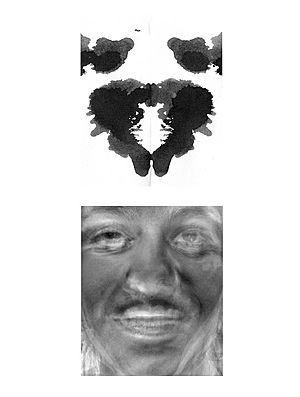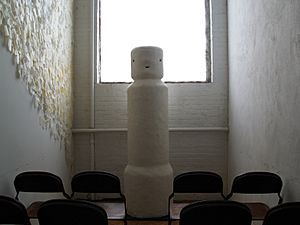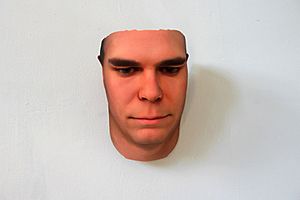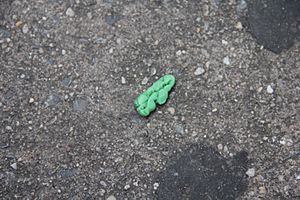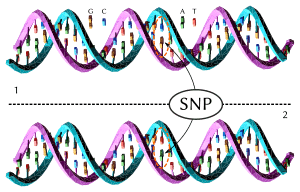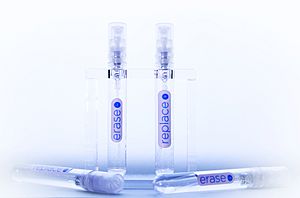Heather Dewey-Hagborg facts for kids
Quick facts for kids
Heather Dewey-Hagborg
|
|
|---|---|

Heather Dewey-Hagborg (photo from her 2013 project DNA Spoofing)
|
|
| Born | June 4, 1982 |
| Alma mater | Bennington College, New York University, Rensselaer Polytechnic Institute |
| Occupation | Information artist |
|
Notable work
|
Stranger Visions |
Heather Dewey-Hagborg (born June 4, 1982, in Philadelphia, Pennsylvania) is an artist who works with information and bio-hacking. She is famous for her project Stranger Visions. In this project, she made portraits from DNA she found on discarded items. These items included hair, cigarettes, and chewing gum. She collected them while living in Brooklyn, New York.
From the DNA, she could figure out things like gender and ethnicity. Then, she used special software and a 3D printer to create a 3D portrait. Her art makes people think about technology and privacy.
Contents
Learning and Teaching
Heather Dewey-Hagborg is an artist who mixes art and science. She studied Information Arts at Bennington College. There, she took computer science classes. These classes helped her create art using algorithms, electronics, and computer programming. She earned her first degree in 2003.
She continued her studies at New York University (NYU). She learned about artificial intelligence and earned a Master's degree in 2007. While at NYU, she organized a robot performance art show. She also showed a piece called Lighter than Air: an experiment in constructing an autonomous flying robot.
For her final project at NYU, she asked, "Can computers be creative?" She created Spurious Memories. This exhibit featured software that could recognize and create unique human faces. It learned by looking at many face images. Heather then earned her PhD in electronic arts from Rensselaer Polytechnic Institute in 2016.
As a teacher, she is interested in art and technology. She has taught at Rensselaer Polytechnic Institute and NYU. She also taught at the School of the Art Institute of Chicago. Since August 2019, she has been a professor at NYU Abu Dhabi.
Art Projects
Totem
One of Heather's early works was Totem (2010). This was a sculpture that explored language and artificial intelligence. It used machine learning technology. Totem listened to conversations at its location. Then, it used algorithms to find common words and phrases.
The sculpture's computer was programmed to speak based on the most common language it heard. Over time, words that were not used often would disappear from its vocabulary. The remaining words were then spoken randomly. A reviewer from The New York Times said Totem had potential. However, due to sound problems, it did not fully connect human speech and technology.
Stranger Visions
Stranger Visions (2012–2013) is a project that uses science to create art. It uses DNA to make realistic 3D portraits. Heather started this project by wondering how much information could be learned from DNA left behind by strangers. She collected samples like hair, skin, and chewing gum in New York City.
She realized that the things that make us human, like hair and skin, can also leave clues about us. Anyone could pick them up and find information. By making realistic sculptures from anonymous people's DNA, she wanted to start a discussion. This discussion was about how DNA profiling, privacy, and genetic surveillance might be used.
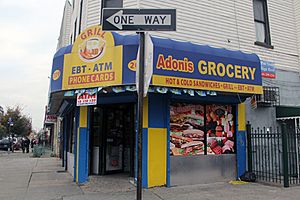
For Stranger Visions, she took a short course at the Genspace laboratory. There, she learned how to extract DNA. She learned how much personal information an amateur biologist could find using biotech.
The process involves treating a sample, like hair, with a gel. This gel helps dissolve the hair. Then, a special primer helps find characteristics like eye color or gender in the genome. She might repeat this process many times. She looked for genetic variations that affect traits like eye color, hair color, and ancestry. This helped her complete a portrait.
After extracting the DNA, she makes many copies of specific parts of the genome. This is done using a technique called Polymerase Chain Reaction (PCR). This process was developed by Kary Mullis, who won a Nobel Prize. These copied parts help identify single nucleotide polymorphisms (SNPs), pronounced "snips." SNPs are tiny differences in DNA that give clues about a person's traits. For example, they can show if someone's eyes might be blue, brown, or green. She sent these results to a company for analysis, using 23andMe for Stranger Visions.
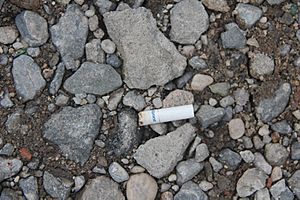
The genetic information she receives is a text file. It contains coded details about the four nucleobases: adenine, thymine, cytosine, and guanine (A, T, C, and G). This data is put into a special computer program she wrote. The program reads the code and gives her a list of traits. These include things like eye color, hair color, skin tone, and gender. She then uses these traits, sometimes up to 50 of them, in a face-generating program. This program creates the 3D portraits.
She had experience with facial recognition programs. She changed an existing program to generate faces instead of just recognizing them. The program changes face features, like the width of the nose and mouth, based on the genetic information. Before making the final 3D print, she creates several versions of the face. She then chooses the one she likes best.
Some people question if Stranger Visions is ethical or legal. They wonder if collecting personal genetic information without permission is right. Even if DNA samples are left behind, it doesn't mean people give up their right to decide how that information is used.
Some laws, like the Human Tissue Act of 2004 in the United Kingdom, stop private people from collecting biological samples for DNA analysis. In the United States, laws about DNA collection are different in each state. They often don't cover private groups. Some states, like New York, make most DNA testing without written consent illegal. Others worry about the information being misused. They fear discrimination based on health issues or "unreasonable" searches by police. Heather said one scientist and one gallery refused her project. They worried it would "cause a fright."
Other critics focus on the growing biohacking movement. Supporters say projects like Stranger Visions help people understand new technology. But others worry about unexpected problems from unregulated experiments.
Some scientists and experts, like Daniel MacArthur and Michelle N. Meyer, say that current technology cannot create an accurate face from DNA. While some genetic markers for facial features are known, all the genes needed for an accurate likeness are not yet identified. Meyer said that Heather's work uses gender, broad ancestry, and a guess at eye color. She noted that hundreds of thousands of people could fit these descriptions. Also, some predictions might be wrong.
The environment, how DNA data is interpreted, and computer limits all affect the outcome. Heather compares her work to a sketch artist. Her portraits only show a general family resemblance to the people whose DNA was used.
Stranger Visions has been shown in exhibitions and is part of the permanent collection at Centre Pompidou in Paris, France. The code for the genetic profiling is available on github.
In 2013, a medical examiner asked Heather for help with an unsolved case. It involved an unidentified woman from 20 years ago. Heather agreed to advise on the case. She knew the portrait based on the woman's DNA would not be perfectly accurate. But she saw it as a good use for this technology. She felt that if it could help loved ones find the woman, it was worth it. Critics worried about "D.I.Y. forensic science" and the role of civilians in state investigations.
Invisible
Heather's work on Stranger Visions led her to think about genetic surveillance. This led her to create two products to remove DNA traces. The first, Erase, is a spray that cleans surfaces of DNA evidence. The second, Replace, is a spray with different genes. It adds foreign DNA to a surface, hiding any original DNA. Heather sees these as a "citizens' defense against the looming DNA surveillance state."
Working with Chelsea Manning
In 2017, Heather worked with activist Chelsea E. Manning on an exhibition. It was called A Becoming Resemblance and opened at Fridman Gallery in New York City. Heather made 3D printed portraits of Manning. She used cheek swabs and hair Manning sent her while in prison.
Heather created Probably Chelsea, which included 30 portraits. These were based on Manning's maternal DNA. The different skin colors and features showed how DNA data can be interpreted in many ways. She also created Radical Love, two portraits Manning chose. These portraits showed how Manning looked during her gender transition in prison, where photos were not allowed. The exhibition showed how much the human genome can be interpreted. Probably Chelsea has been shown in many places, including Berlin and the Netherlands.
Probably Chelsea is now in the permanent collection of the Exploratorium in San Francisco. Radical Love is in the permanent collections of the New York Historical Society and the Victoria and Albert Museum in London.
Xeno in Vivo
Heather Dewey-Hagborg’s Xeno in Vivo (2024) was a live multimedia opera. It premiered at the Exploratorium in San Francisco in March 2024. The opera explores xenotransplantation. This is when living cells or organs are moved from one species to another. It also looks at whether CRISPR gene editing is a new technology or like old practices of selective breeding.
The performance includes audio and video of scientists and animals. Heather narrates, sharing conversations she had with scientists about the ethics of xenotransplantation. The show uses projections, sculptures, and live beating heart cells on stage. Four opera singers perform with original music by Bethany Barrett.
Other Exhibitions and Awards
Heather Dewey-Hagborg's art has been shown in many places. These include PS1 MoMA in New York, the Science Gallery in Dublin, Ireland, and the Ars Electronica Center in Linz, Austria.
She has also created other works, such as:
- Trace Recordings: Surveillance and Identity in the 21st Century in Australia.
- Cyber In Securities in Washington, D.C.
- Plugged In: Interactive Art in Electronic Media in New Jersey.
- DNA and Dust (with Paul Hazelton) in New York.
- Unlanguage (with Adriana Varella) in Poland.
- Open Circuit at PS1 MoMA.
- Jaaga Dhvani in India.
She has received several grants and awards:
- 2008 Artist's Residency and Grant, Sculpture Space.
- 2012 Residency at Eyebeam.
- 2012 Artist's Residency and Jerome Foundation Grant, Clocktower Gallery.
- 2013 VIDA 15.0 Art and Artificial Life International Awards, special mention.
- 2016 Creative Capital Award.
- 2019 New Technology Art Award for "Probably Chelsea."
Images for kids
See also
 In Spanish: Heather Dewey-Hagborg para niños
In Spanish: Heather Dewey-Hagborg para niños
- Parabon NanoLabs, which uses a similar technique for forensic artwork


